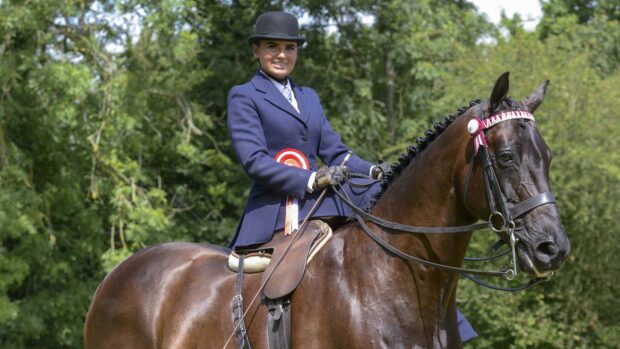Katie Jerram-Hunnable (pictured) has been involved with horses all her life; she began showing at the age of seven and started producing show horses in her early 20s. Katie currently produces horses for The Queen. She has won at Horse of the Year Show (HOYS) and the Royal International (RIHS) on many occasions and currently trains horses and riders at her parents’ yard in Essex, with her husband, the former Olympic eventer Chris Hunnable. How to teach horse to gallop? Katie shares her advice…
Training the stars
I had a wonderful hunter called Noble Clover whom I competed in weights, workers and ladies’ classes. He was very bold but could be strong, as I found to my cost at Royal Windsor. I failed to stop after galloping him, and we jumped clean out of the arena over the Horse & Hound banner.
I tend to advise people not to over-bit their horses, but on this occasion, I decided better brakes were needed so I bridled him accordingly. He went on to win at HOYS later that year as a heavyweight and we never looked back.
Many riders panic in the show ring when asked by the judge or steward to gallop. They come off the corner too quickly, kick on, yet often simultaneously snatch at the horse’s mouth, causing it to hollow rather than to lower and lengthen correctly.
Anticipation is also often a problem for both horse and rider. The only solution is to practise the gallop pace at home, as you would any other, so you can execute it in a controlled manner.
How to teach horse to gallop
1. Count how many natural canter strides you are achieving down the long side of the arena. This will vary depending on the size of your arena, and the height and length of stride of your horse.
Deepen your seat and shorten the natural rhythm, fitting in two extra strides down the long side — for example, if your horse’s natural canter is 11 strides, aim to ride 13 strides.
Go back to the natural canter, lighten your seat and lengthen the stride, aiming to ride three strides fewer — in this case, eight strides down the long side of the arena. Then deepen your seat and shorten back to the natural rhythm again.
2. Go up and down this exercise on both reins as part of your weekly schooling regime, but be sure to include other exercises to keep the horse fresh and enjoying work.
Keep practising this exercise until you are confident you can ask the horse to alter its frame on command, without anticipating or panicking.
3. Aim to lighten the seat rather than dig in with the heels. You need to keep your hands soft to allow the horse to move forwards.
4. Practise moving the horse up and down within the canter so this becomes part of the schooling exercise, rather than something which is dramatic and exciting.
Consider this…
- Once in the ring, be aware of where the steward is likely to ask you to gallop and where the judge is watching the gallop. Judges do not necessarily watch everything.
- I begin my preparation for the gallop on the short side of the ring before the corner where I am being asked to gallop. This means I am building the pace gradually, allowing the horse to extend, so my optimum gallop is in the frame immediately in front of the judge. Don’t wait until the last minute then blast off the corner in a panic and hope things will go right.
- Find a space that suits you and your horse. I prefer to go first, or behind someone who I know will set a good pace. Don’t be rushed, and don’t be afraid to circle if you aren’t happy with your position.
- Practise galloping at home, using the exercise I have described. You would not put a horse into the show ring without polishing its other paces; the gallop should not be an exception. A good gallop can win or lose the class.
You may also be interested in…

#SundaySchool: showing supremo on the importance of using lateral work
This is a simple leg-yielding exercise from Sue-Helen Shuttleworth (pictured) for both established and young horses, enabling the rider to

#SundaySchool: how to improve lead changes over a fence
This exercise, as explained by five-star Irish event rider, Camilla Speirs (pictured), explains how to improve lead changes over a

Subscribe to Horse & Hound magazine today – and enjoy unlimited website access all year round
Horse & Hound magazine, out every Thursday, is packed with all the latest news and reports, as well as interviews, specials, nostalgia, vet and training advice. Find how you can enjoy the magazine delivered to your door every week, plus options to upgrade your subscription to access our online service that brings you breaking news and reports as well as other benefits.




